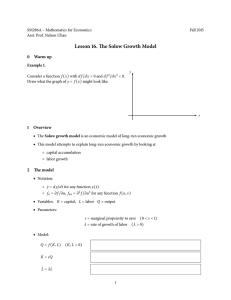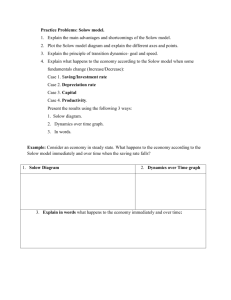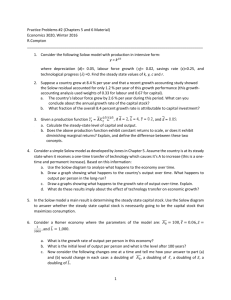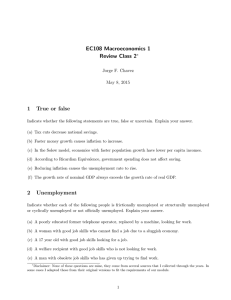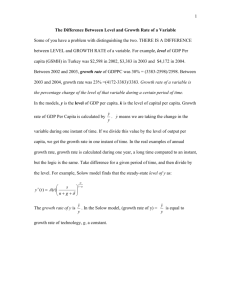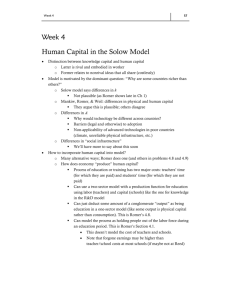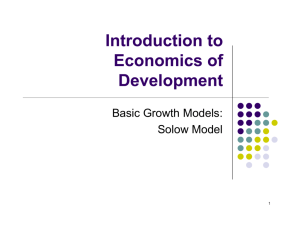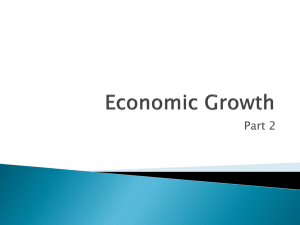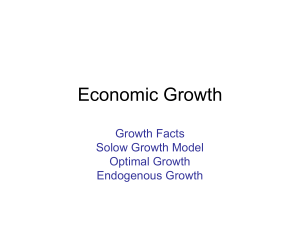Introduction to Economic History: What Is the Point?
advertisement
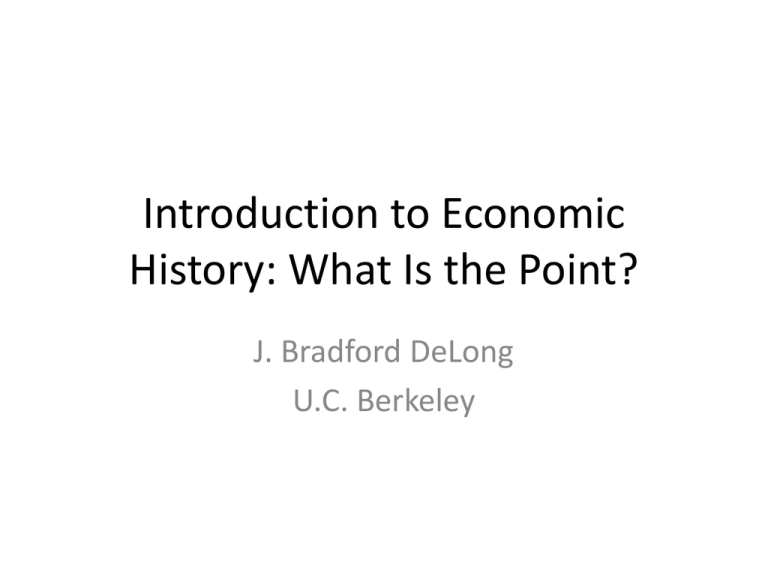
Introduction to Economic History: What Is the Point? J. Bradford DeLong U.C. Berkeley Readings • Robert M. Solow (1985), "Economic History and Economics", American Economic Review 75:2 (May), pp. 328-331 <http://www.jstor.org/stable/1805620> • Kenneth J. Arrow (1985), "Maine and Texas", American Economic Review 75:2 (May), pp. 320323 <http://www.jstor.org/stable/1805618> • Isaac Asimov (1953), Second Foundation (New York: Gnome Press), chapter 8 <http://tinyurl.com/dl2014014b> Six Passages • Solow: “You could drop a modern economist…” • Asimov: “‘Do you recognize any portion?’…” • Solow: “Damon Runyon’s law that nothing between human beings is more than three-to-one…” • Arrow: “The cultural differences… are precipitates of past events…” • Solow: “If the proper choice of a model depends on the institutional context…” • Arrow: “There is a bias toward flattening out the peculiarities…” Robert Solow: : “You could drop a modern economist…” • You could drop a modern economist from a time machine--a helicopter, maybe, like the one that drops the money--at any time, in any place, along with his or her personal computer; he or she could set up in business without even bothering to ask what time and which place. In a little while, the up-to-date economist will have maximized a familiar-looking present-value integral, made a few familiar log-linear approximations, and run the obligatory familiar regression. The familiar coefficients will be poorly determined, but about one-twentieth of them will be significant at the 5 percent level, and the other nineteen do not have to be published... the data are just barely consistent with your thesis adviser's hypothesis that money is neutral (or nonneutral, take your choice) everywhere and always, modulo an information asymmetry, any old information asymmetry, don't worry, you'll think of one. All right, so I exaggerate. You will recognize the kernel of truth.... Of course there are holdouts against this routine, bless their hearts.... Asimov: “‘Do you recognize any portion?’…” • They stood together in the light. Each wall was thirty feet long, and ten high. The writing was small and covered every inch. “This is not the whole [psychohistorical] Plan,” said the First Speaker. “To get it all upon both walls, the individual equations would have to be reduced to microscopic size—but that is not necessary. What you now see represents the main portions of the Plan till now. You have learned about this, have you not?” • “Yes, Speaker, I have.” • “Do you recognize any portion?” • A slow silence. The student pointed a finger.... “It,” faltered the Student, “is a Rigellian integral, using a planetary distribution of a bias indicating the presence of two chief economic classes on the planet, or maybe a Sector, plus an unstable emotional pattern.” • “And what does it signify?” • “It represents the limit of tension, since we have here... a converging series.”… Robert Solow: “Damon Runyon’s law…” • A... complicated system... cannot conduct controlled experiments... hypotheses are themselves complex... a social science... subject to Damon Runyon's Law that nothing between human beings is more than three to one... narrowly economic activity is embedded in a web of social institutions, customs, beliefs, and attitudes... affected by these background factors.... As soon as time-series get long enough to offer hope of discriminating among complex hypotheses, the likelihood that they remain stationary dwindles away, and the noise level gets correspondingly high. Under these circumstances, a little cleverness and persistence can get you almost any result you want.... If the project of turning economics into a hard science could succeed, it would surely be worth doing. No doubt some of us should keep trying.... The economic historian can ask whether this or that [model-]story rings true when applied in earlier times or other places, and, if not, why not.... Economic history can offer the economist a sense of the variety and flexibility of social arrangements... the interaction of economic behavior and other social institutions... Kenneth Arrow: “cultural differences… are precipitates of past events…” • What about the uses of history in the development of economic analysis?... Let me pick two... the use of economic history as a source of empirical evidence for testing theories and estimating relations.... A second use of history in the development of economic analysis is a definition of its historical conditioning.... Rostovtzeff found the early Roman Empire to be governed by modern economic institutions, mobility, profit seeking, and so forth. He has been ridiculed for this by the current leading authority, Moses Finley, who finds little evidence of rational economic behavior in the ancient world.... Closely intertwined with historical conditioning of theory is national or cultural conditioning... even between such economically and culturally similar nations as the United States and Canada.... The cultural differences between nations, with all their implications for polity and economy, are precipitates of past events.... It will always be true that practical understanding of the present will require knowledge of the past... Robert Solow: “the proper choice of a model depends on the institutional context…” • If the proper choice of a model depends on the institutional context-and it shouldthen economic history performs the nice function of widening the range of observation... [teaching] something about the range of possibilities.... W.H.B. Court... on Coal:… – Observers who found the conduct of the mineworkers puzzling assumed that... a man who finds himself faced with the possibilities of higher earnings will be prepared to put out extra effort to obtain them. An assumption about the conduct of an individual is... also an assumption... about the society in which he lives.... The individual's demand for income, his views upon the getting and spending of money, are usually formed by the part of society which he is most in touch with. For most men the social code, whatever it may be in their time and place, is something which they accept as given and take over with little demur or questioning. Before one can assume that a demand for additional income existed on the coalfields and could easily translate itself into extra work, one has to ask whether the mining community had those standards or those habits. If it did not, and if it was unable to develop them in a short time, then even a rapid rise of wage rates might bring about no appreciable change in the working habits of the industry..... • An economic historian should be an "observer and re-creator of the codes, loyalties and organizations which men create and which are just as real to them as physical conditions." Add to that a command over two-stage least squares, and you have the kind of economic historian from whom theorists have most to learn, if only they are willing to try... Kenneth Arrow: “There is a bias toward flattening out the peculiarities…” • The example of national income analysis does remind us of a danger in the use of economic theory in economic history. There is a bias towards flattening out the particularities of the past. The more one uses categories drawn from the need to generalize, the less marked is the difference among the instantiations....
